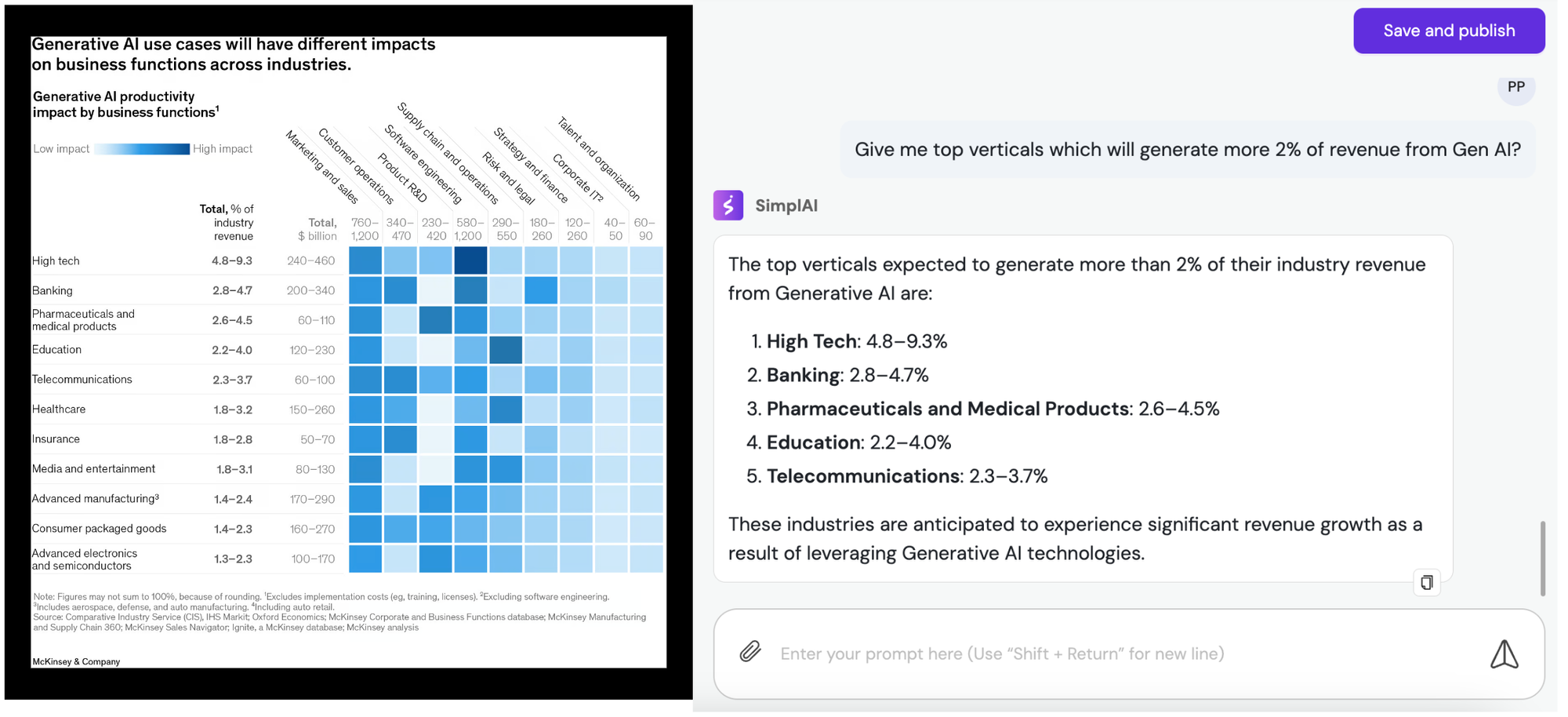Virtual Research Analyst - Harnessing Agentic and Multi-modal RAG

Are you part of a market research firm, a consulting team, or an internal consumer research group? If so, you know the challenges that come with the territory.
As a consultant or market research analyst, your daily routine often involves navigating a maze of slide decks and research reports. You have a treasure trove of reports spanning various segments, groups, and across years at your fingertips. However, sifting through this wealth of information to identify the most relevant documents can be daunting.
You spend significant time identifying the most relevant documents, extracting key insights, and synthesizing findings to inform your strategies. This complex process can consume 50-60% of your productivity, leaving you with less time for critical analysis and strategic thinking.
Building an agentic AI system with a multi-modal RAG pipeline can transform this landscape for firms like yours. By leveraging advanced retrieval and generation capabilities, you can streamline your workflow, enhance your data analysis, and ultimately boost your effectiveness in delivering actionable insights.
Understanding the Problem: Market Research Reports
Market research reports are not just collections of text; they are complex documents layered with information that communicate insights, analyses, and findings. These documents often include a variety of formats that serve different purposes:
- Concise Text: Insights are frequently presented in short, condensed bullet points or paragraphs, ensuring that key takeaways are easy to digest.
- Charts and Graphs: Data visualizations are extensively used to represent trends and comparisons, making complex data more accessible.
- Tables: Table structures to summarize key metrics and performance indicators, providing a quick reference for critical information.
- Images and Visualizations: Screenshots, infographics, and other images convey industry-specific trends, enhancing the overall understanding of the data.
- Contextual Relationships: The connections between different sections, charts, and tables can only be fully understood by a human reader, who can grasp the underlying insights and implications.
- Inter-Slide Relationships: In presentations, the connections between slides introduce another layer of complexity, as insights may flow from one slide to the next, requiring a holistic view of the content.
Now, imagine the challenge of building a RAG system capable of processing 1,000+ reports like these—each spanning hundreds of slides or pages, with unique formats and data types. The task requires advanced retrieval capabilities over multimodal data.
How We Built a Research Analyst Agentic RAG Using SimplAI Platform`
The First Step: Preprocessing Workflow
We established a custom preprocessing workflow using no-code tools feature, designed to extract data from various elements within the research reports:
- Data Tables and Charts: We implemented extraction algorithms to convert tables and charts into structured JSON formats, preserving inferred context for better understanding.
- Images: Each image was processed to include explanatory metadata, detailing the content and context inferred from surrounding text.
- Complex Visualizations: For intricate visualizations, we employed a human-in-the-loop approach to ensure accurate interpretation and contextualization of the data.
The Second Step: Metadata for Contextual Relevancy
To ensure accurate retrieval and contextual understanding, we incorporated metadata at different levels, helping structure the information across the reports:
- Document-Level Metadata: Includes high-level details such as the document’s description, date of creation, keywords, industry segments, and focus areas (e.g., report on emerging markets or product trends). This provides a comprehensive overview of the entire report’s context.
- Slide-Level Metadata: Added specific metadata to each slide, including a brief description, relevant keywords, chart tags, and page numbers. For example, a slide might be tagged with "revenue growth" or "market competition," enabling faster, more relevant searches.
This approach ensures that each part of the report, from the document overview to individual slides and visualizations, is easily searchable and contextually relevant.
The Third Step: Indexing Over Multimodal Data
To build a highly reliable multi-modal RAG system, we conducted extensive experiments with different indexing techniques. Again using our no-code knowledge base:
- Vector Databases and Embeddings: We tested several vector databases and embedding models to see how well they indexed multimodal data, including text, charts, and images.
- Reranking Algorithms: We refined search results by applying reranking methods that boosted the relevance of top results, ensuring accurate, context-based answers.
- K-Results Optimization: We adjusted the k-results (results per query) to balance speed and retrieval accuracy, optimizing system performance.
- Metadata Filtering: We used document- and slide-level metadata as filters, enhancing search precision.
This phase helped us fine-tune the right tools and parameters for a scalable, high-performing RAG system.
The Fourth Step: Agentic RAG as a Research Analyst
In the final step, we deployed the Agentic RAG to function as a virtual research analyst using our no-code agent builder. This system leverages powerful agent capabilities to enhance user interaction:
- Conversational Agent: The agent interacts with users by retrieving information solely from the predefined knowledge base, ensuring responses are accurate and reliable.
- Grounded Insights: We configured the system to generate insights that are fully grounded in retrieved data, eliminating the risk of hallucinations and ensuring the highest level of trustworthiness.
- Suggestive Replies: The agent also provides context-aware, suggestive replies, helping users navigate large research reports or datasets more effectively.
- Citations & Page Screenshots: For transparency, the agent includes citations in its responses, linking back to original sources with page-level screenshots, offering a visual anchor to the retrieved data.

This was all built using our no-code agent builder, where features like suggestive replies, citations, and grounded insights were configured with minimal development effort.
Getting Started
Unlock the power of agentic RAG with multi-modal capabilities today!
With SimplAI, you can revolutionize how you augment your organization with an Agentic workforce to boost productivity and unlock insights.
Don’t miss out on the opportunity to stay ahead in the rapidly evolving landscape of AI.
Schedule a personalized demo or consultation with our experts now, and let’s explore how we can tailor our solutions to meet your specific needs and drive your success!
Reach out to us at [email protected] if you’d like to learn more.

